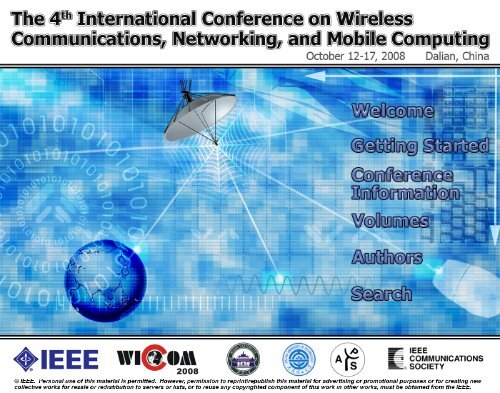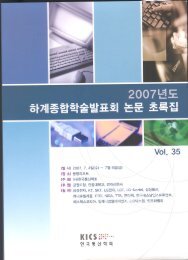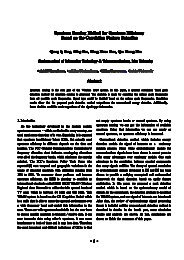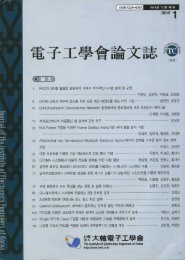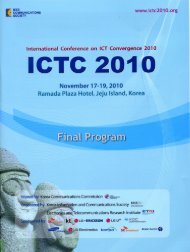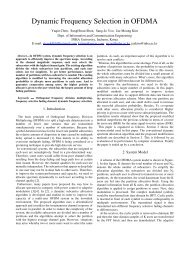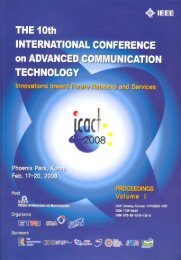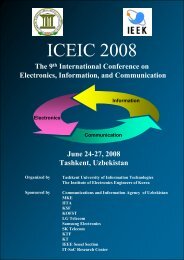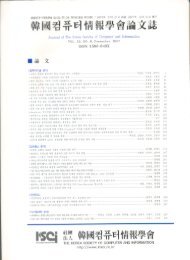Cyclic Autocorrelation based Blind OFDM Detection and ...
Cyclic Autocorrelation based Blind OFDM Detection and ...
Cyclic Autocorrelation based Blind OFDM Detection and ...
Create successful ePaper yourself
Turn your PDF publications into a flip-book with our unique Google optimized e-Paper software.
© IEEE. Personal use of this material is permited. However, permission to reprint/republish this material for advertising or promotional purposes or for creating new<br />
colective works for resale or redistibution to servers or lists, or to reuse any copyrighted component of this work in other works, must be obtained from the IEEE.
Papers by Session<br />
❑<br />
❑<br />
❑<br />
❑<br />
❑<br />
❑<br />
❑<br />
Selection of Sensing Nodes in Cognitive Radio System<br />
Based on Correlation of Sensing Information<br />
Yanzan Sun, Honglin Hu, Fuqiang Liu, Huiyue Yi <strong>and</strong> Xinhong Wang<br />
Performance Evaluation of a CR-Based WRAN System<br />
using Spectrum Utilization Efficiency<br />
Hyunduk Kang, Heonjin Hong <strong>and</strong> Changjoo Kim<br />
Channel Sensing Algorithm Based on Neural Networks for<br />
Cognitive Wireless Mesh Networks<br />
Xiang-Lin Zhu, Yuan-An Liu, Wei-Wen Weng <strong>and</strong> Dong-Ming Yuan<br />
<strong>Cyclic</strong> <strong>Autocorrelation</strong> Based <strong>Blind</strong> <strong>OFDM</strong> <strong>Detection</strong> <strong>and</strong><br />
Identification for Cognitive Radio<br />
Ning Han, Guanbo Zheng, Sung Hwan Sohn <strong>and</strong> Jae Moung Kim<br />
A Novel Power Control Algorithm for Cognitive Radio in<br />
Environmental Monitoring<br />
Shu Wang, Zhuo Cheng, Fuping Hu <strong>and</strong> An Li<br />
Analysis of Linear Receivers in a Target SINR Game for<br />
Wireless Cognitive Networks<br />
Tianming Li <strong>and</strong> Sudharman K. Jayaweera<br />
Demodulation-Oriented Automatic Modulation Identification<br />
Algorithm<br />
Qixing Chen <strong>and</strong> Guozhong Zhou<br />
Click on a title to see the paper.<br />
Main Menu<br />
Volumes<br />
Sessions<br />
Authors
<strong>Cyclic</strong> <strong>Autocorrelation</strong> <strong>based</strong> <strong>Blind</strong> <strong>OFDM</strong> <strong>Detection</strong><br />
<strong>and</strong> Identification for Cognitive Radio<br />
Ning Han, Guanbo Zheng, Sung Hwan Sohn, Jae Moung Kim<br />
INHA-WiTLAB, INHA University<br />
253 Younghyun-dong, Nam-gu, 402-751<br />
Incheon, Korea<br />
neil_han@ieee.org, gbzheng@gmail.com, sunnyshon@gmail.com, jaekim@inha.ac.kr<br />
Abstract—Cognitive radio is considered as a promising technique<br />
to increase the utilization of limited spectral resource. The key<br />
issue in cognitive radio is to design a reliable spectrum sensing<br />
method that is able to detect the signal in the target channel as<br />
well as to recognize different signals. In this paper, focusing on<br />
classifying different <strong>OFDM</strong> signals, we propose a two-step<br />
detection <strong>and</strong> identification approach. The key parameters to<br />
separate different <strong>OFDM</strong> signals are the subcarrier spacing <strong>and</strong><br />
guard interval. A simple but reliable peak detection method is<br />
adopted in the first step, while a peak searching method is used<br />
to determine the length of guard interval. Simulations are<br />
carried out in AWGN to verify the validation of the proposed<br />
method. It is shown that our method can satisfy the detection<br />
<strong>and</strong> identification requirement with a low false alarm<br />
probability.<br />
Keywords-cognitive radio; spectrum sensing; <strong>OFDM</strong>;<br />
cyclostationary; signal detection <strong>and</strong> identification<br />
I. INTRODUCTION (HEADING 1)<br />
It is commonly believed that there is a scarcity of spectrum<br />
availability at frequencies that can be economically used for<br />
wireless communications, especially in the b<strong>and</strong>s below 3 GHz<br />
[1]. However, according to the measurements taken in [2], the<br />
shortage is mainly caused by the spectrum policy under which<br />
the spectrum is licensed to a limited number of<br />
implementations. Cognitive radio provides the opportunity to<br />
utilize the vacant spectrum resources while helping to prevent<br />
interference to primary users that own the frequency b<strong>and</strong>s. It<br />
is defined as an intelligent wireless communication system that<br />
is aware of its surrounding environment, <strong>and</strong> learns from the<br />
environment <strong>and</strong> adapts its internal states to statistical<br />
variations in the incoming RF stimuli by making<br />
corresponding changes in certain operating parameters in real<br />
time [3]. The new functionality (spectrum sensing) requires<br />
that the radio is able to separate the vacant frequency b<strong>and</strong>s<br />
from those filled with primary user signals accurately.<br />
It is well known that by splitting a single high-rate data<br />
This work was supported by the Korea Science <strong>and</strong> Engineering<br />
Foundation (KOSEF) through the National Research Lab. Program funded by<br />
the Ministry of Education, Science <strong>and</strong> Technology (No. M10600000194-<br />
06J0000-19410). This work was supported by the Korea Science <strong>and</strong><br />
Engineering Foundation (KOSEF) grant funded by the Ministry of Education,<br />
Science <strong>and</strong> Technology (MEST) (No. R01-2006-000-10266-0(2008)).<br />
978-1-4244-2108-4/08/$25.00 © 2008 IEEE<br />
stream into a number of lower rate subcarriers, <strong>OFDM</strong> holds<br />
several advantages including robustness against frequency<br />
selective fading or narrowb<strong>and</strong> interference [4]. Recently, due<br />
to the booming of WiFi <strong>and</strong> WiMAX, <strong>OFDM</strong> <strong>based</strong> systems<br />
are becoming the trend for next generation wireless<br />
communications. Therefore, the detection method separating<br />
<strong>OFDM</strong> signal from other single carrier signal or r<strong>and</strong>om noise<br />
comes to the frontier. [5] proposed to exploit the embedded<br />
periodicity among the subcarriers in <strong>OFDM</strong> signal. [6]<br />
developed several criteria <strong>based</strong> on the time domain<br />
periodicity introduced by the cyclic prefix in DVB-T <strong>OFDM</strong><br />
symbol. These approaches require either the number of<br />
subcarriers or the spacing between consecutive subcarriers in a<br />
priori. However, different <strong>OFDM</strong> systems usually own their<br />
unique parameters due to various applications. Even in a single<br />
<strong>OFDM</strong> system, there are several operation modes with<br />
different parameters to achieve various transmission data rates.<br />
These make the detector almost impossible to know the<br />
information in advance. Thus, the existing methods are<br />
impractical to detect <strong>OFDM</strong> signal blindly.<br />
In this paper, by considering the uncertainties in the<br />
detector, we proposed a time domain cyclostationarity <strong>based</strong><br />
approach to detect <strong>and</strong> identify <strong>OFDM</strong> signal from r<strong>and</strong>om<br />
noise. The key parameters to discriminate different <strong>OFDM</strong><br />
signals are the subcarrier spacing <strong>and</strong> duration of guard<br />
interval. The proposed approach consists of two steps. The first<br />
step is to detect the <strong>OFDM</strong> signal from r<strong>and</strong>om noise simply<br />
by recognizing the symmetric peaks in the autocorrelations,<br />
which is a special case of the cyclic autocorrelation function.<br />
The subcarrier spacing is calculated as long as the <strong>OFDM</strong><br />
signal is detected. In the second step, by searching the cycle<br />
frequencies, the length of guard interval is calculated to<br />
recognize different <strong>OFDM</strong> signals. The main advantage is that<br />
the proposed method does not require the FFT process. Since<br />
the number of subcarrier is unknown, the mismatch of FFT<br />
parameters will reduce the performance of any FFT <strong>based</strong><br />
detection methods.<br />
The rest of our paper is organized as follows; Section II<br />
describes the time domain cyclostationarity of <strong>OFDM</strong> signal in<br />
terms of cyclic correlation function (CAF). Section III presents<br />
the proposed detection procedure <strong>and</strong> criteria <strong>based</strong> on the<br />
blind assumption. Simulation results are discussed in Section
IV to show the feasibility <strong>and</strong> advantages of the proposed<br />
method. Finally, we conclude the paper in Section V.<br />
II. CYCLOSTATIONARITY OF <strong>OFDM</strong> SIGNAL<br />
Cyclostationary r<strong>and</strong>om process has been studied since the<br />
1980s. It is well known that the signal in wireless<br />
communications can be modeled as a cyclostationary r<strong>and</strong>om<br />
process instead of stationary one. It gives us another view to<br />
analyze the unique characteristics embedded in signals. The<br />
basic concept of cyclostationary r<strong>and</strong>om process is reviewed in<br />
this section <strong>and</strong> the characteristics in the CAF of <strong>OFDM</strong> signal<br />
is exploited <strong>and</strong> discussed as the preliminary of the proposed<br />
detection <strong>and</strong> identification method.<br />
A. Definition of CAF<br />
A process, for instance x(t), is said to be cyclostationary in<br />
the wide sense if its mean <strong>and</strong> autocorrelation are periodic with<br />
some period, say T [7]:<br />
( ) ( )<br />
m t+ T = m T<br />
(1)<br />
x x<br />
τ τ τ τ <br />
Rxt+ T + , t+ T − = Rxt+ , t−<br />
<br />
2 2 2 2<br />
where R ( t τ 2, t τ 2)<br />
x + − , the function of two independent<br />
variables t <strong>and</strong> , is periodic in t with period T for each value of<br />
<br />
( τ 2, τ 2)<br />
Rxt+ t−<br />
is polyperiodic in t for each . The<br />
associated Fourier series for this function is<br />
τ τ <br />
R t t R e<br />
( τ )<br />
(2)<br />
α i2παt x + , − =<br />
x<br />
2 2<br />
{ α}<br />
(3)<br />
for which { Rx } α are the Fourier coefficients,<br />
T 2<br />
α 1<br />
−i2παt<br />
x ( τ) x(<br />
, τ)<br />
T −T<br />
2<br />
R = R t e dt (4)<br />
<strong>and</strong> the sum over includes all integer multiples of the<br />
reciprocal of the fundamental period T. is the cycle<br />
frequency, which could be used to separate different signals.<br />
B. CAF of <strong>OFDM</strong> signal<br />
The CAF of baseb<strong>and</strong> <strong>OFDM</strong> signal can be calculated as<br />
follows [6]:<br />
( πN∆fτ) ( π∆τ) α A sin<br />
n Rx= e<br />
T sin f<br />
s<br />
∞<br />
<br />
πα ( ) τ<br />
−i2n−f N −1<br />
i2π∆f τ<br />
2<br />
( ) ( α )<br />
⋅ e G f G − f df<br />
−∞<br />
Where G(f) is the Fourier transform of the rectangular pulse<br />
shape g(t). A is the variance of the symbol sequence. Ts = Tu<br />
+ Tg is the symbol duration, where Tu = 1/f is the useful<br />
n<br />
(5)<br />
978-1-4244-2108-4/08/$25.00 © 2008 IEEE<br />
symbol duration, Tg is the duration of the guard interval <strong>and</strong><br />
f is the subcarrier spacing. The typical CAF magnitude of<br />
<strong>OFDM</strong> signal is shown in Fig. 2, in which is normalized to<br />
1/Ts <strong>and</strong> is normalized to useful symbol duration. The signal<br />
exhibits discrete cyclic autocorrelation surfaces for the cycle<br />
1<br />
frequencies n = n/Ts, which peak at τ =± =± T where<br />
u<br />
∆f<br />
sin ( πN∆fτ) the factor<br />
takes its maximum value. It is<br />
sin ( π∆fτ) clear that is selected as the integer number of 1/Ts, <strong>and</strong> when<br />
τ =± T , the CAF values exhibit peak properties. As the <br />
u<br />
value increases the peak decreases. If the value of Ts <strong>and</strong> Tu is<br />
known in the detector, we are able to design the detection<br />
process to catch the peaks exhibited in the CAF functions.<br />
However, in blind detection <strong>and</strong> identification, the parameters<br />
of received signal is unknown by the detector of cognitive<br />
radio. It means the values of at which CAF exhibit peaks are<br />
unable to obtain a priori.<br />
Figure 1. CAF with step between equals integer number of 1/Ts<br />
Figure 2. CAF with step between equals fraction number (1/20) of 1/Ts
In order to detect all possible <strong>OFDM</strong> signals, a step size of<br />
that is smaller than subcarrier spacing should be selected to<br />
calculate the CAF of received signal as shown in Fig. 3. Thus,<br />
we can observe the changes in the CAF of <strong>OFDM</strong> signal in<br />
details, as illustrated at u T τ =± , the pattern of which is better<br />
for us to underst<strong>and</strong> the characteristic of CAF of <strong>OFDM</strong><br />
signal. It is clear that the peak values decrease when takes<br />
the integer number of 1/Tu. However, there are other smaller<br />
peaks between them. Since the information of Tu is unknown,<br />
the detector has to check the CAF with a step size that is<br />
smaller than the subcarrier spacing.<br />
Figure 3. CAF when =Tu with step size between equals fraction number<br />
(1/20) of 1/Ts<br />
III. BLIND DETECTION AND IDENTIFICATION OF <strong>OFDM</strong><br />
SIGNAL<br />
<strong>OFDM</strong> has been selected for most of the future wireless<br />
communication st<strong>and</strong>ards. For various operation environments<br />
<strong>and</strong> applications, different values of parameters are selected to<br />
implement the system with the purpose of achieving optimum<br />
capacity. These parameters include number of subcarriers,<br />
subcarrier spacing, the length of guard interval, etc. Even in<br />
the same st<strong>and</strong>ard, there are several operation options in which<br />
the parameters are setup differently to achieve various<br />
transmission data rates. Thus, when detecting the incoming<br />
signal, it is impossible to select the detection criteria <strong>based</strong> on<br />
the known <strong>OFDM</strong> parameters as in [6]. Therefore, in order to<br />
fit into the practical application, the parameters of <strong>OFDM</strong><br />
signal should be treated as unknown factors at the detector. In<br />
this paper, we propose a blind detection <strong>and</strong> identification<br />
method for cognitive radio, which consists of two steps: the<br />
simple but reliable peak detection method that calculates the<br />
subcarrier spacing in the first step <strong>and</strong> a peak searching<br />
method employed to determine the length of guard interval in<br />
the second step. We assume that the observation time is longer<br />
than one <strong>OFDM</strong> symbol <strong>and</strong> the step size between each is<br />
selected as the fractional value of subcarrier spacing such as<br />
1/20, 1/10.<br />
A. <strong>OFDM</strong> Signal <strong>Detection</strong><br />
The blind detection of <strong>OFDM</strong> signal could be considered<br />
as a binary hypotheses test:<br />
1<br />
() = ()<br />
() = () + ()<br />
H 0 : r t w t signal absent<br />
H : r t s t w t signal present<br />
where r(t) is the received signal, s(t) <strong>and</strong> w(t) represent the<br />
<strong>OFDM</strong> signal <strong>and</strong> noise respectively. As described previously,<br />
the peaks in the CAF of <strong>OFDM</strong> signal are mainly due to the<br />
cyclic prefix in <strong>OFDM</strong> symbol. This feature is employed as<br />
the main criterion to separate <strong>OFDM</strong> signal from noise.<br />
In the first step of the proposed scheme, we employ the<br />
simple peak detection method that detects the symmetric peaks<br />
when = 0, as demonstrated in Fig. 4. Based on the<br />
characteristic of <strong>OFDM</strong> symbol with cyclic prefix, we<br />
consider that the time period between the major peaks should<br />
be equal to Tu, the effective symbol duration.<br />
Figure 4. CAF when =0 as a function of <br />
In order to catch these symmetric peaks, we formulate the<br />
amplitude of CAF with equal to 0 as the test statistic, which<br />
is expressed as follows:<br />
Z = R<br />
1<br />
0<br />
r<br />
( τ )<br />
2<br />
( πN∆fτ) ( π∆τ) A sin<br />
= ⋅ −<br />
T sin f<br />
s<br />
( ) sin ( N∆f )<br />
T sin ( π∆fτ) 978-1-4244-2108-4/08/$25.00 © 2008 IEEE<br />
N −1<br />
i2π∆f τ<br />
2 e<br />
∞<br />
i2π fτ<br />
e G( f ) G( −∞<br />
f ) df<br />
δ τ π τ <br />
= A + N0<br />
s <br />
From the theoretical analysis, Z1 takes the largest peak<br />
when = 0 <strong>and</strong> two other peaks when u T τ =± , which agrees<br />
with our expectation. Since the subcarrier spacing is<br />
determined, it could be used for signal identification.<br />
2<br />
2<br />
(6)
B. <strong>OFDM</strong> Signal Identification<br />
As explained before, different <strong>OFDM</strong> signals can be<br />
classified by the parameters such as the length of guard<br />
interval, subcarrier spacing <strong>and</strong> so on. In the first step of the<br />
proposed scheme, subcarrier spacing has been calculated after<br />
the <strong>OFDM</strong> signal is detected. Therefore, another parameter,<br />
length of guard interval is the target of identification in second<br />
step.<br />
Since the duration of useful symbol has been determined in<br />
the first step, we can observe the CAF for =Tu, as shown in<br />
Fig. 1 <strong>and</strong> Fig. 3. By inserting the =Tu to (5), the test statistic<br />
could be expressed as a function of n, as described in the<br />
following:<br />
2<br />
( )<br />
Z = R T<br />
αn<br />
x u<br />
2<br />
( π N∆fTu) ( π∆<br />
)<br />
N −1<br />
∞<br />
A sin<br />
i2π∆f Tu<br />
2<br />
−i2π( αn−<br />
f ) Tu<br />
= e ⋅ e G( f ) G( α n − f ) df<br />
T sin fT <br />
s u<br />
−∞<br />
The only term determining Z2 is the integration term of<br />
pulse signal. In order to observe the more detail pattern of<br />
CAF, we employ the step size of each as the fractional value<br />
of subcarrier spacing. The smaller step size of each is the<br />
more detailed pattern we can observe. In our simulation, step<br />
size identical to 1/20 of subcarrier spacing is utilized, while the<br />
peaks of CAF are shown in Fig. 3. Therefore, our purpose is to<br />
determine the distance of two maximum peaks in domain,<br />
which is equal to the reciprocal of Ts. We proposed to employ<br />
the cycle frequency searching scheme to determine the two<br />
maximum peaks in the CAF pattern. After calculating the Ts,<br />
we can easily obtain the length of guard interval as Ts-Tu.<br />
IV. SIMULATIONS AND DISCUSSIONS<br />
Simulations are carried out to evaluate the performance of<br />
the proposed blind detection <strong>and</strong> identification method. <strong>OFDM</strong><br />
signal used in the simulations belongs to four modes with<br />
different subcarrier spacing <strong>and</strong> guard interval. The subcarrier<br />
spacing is expressed in terms of the number of subcarriers in<br />
the same b<strong>and</strong>, such as 1k <strong>and</strong> 2k. The length of guard interval<br />
is select from 1/4 <strong>and</strong> 1/8 of useful symbol duration. The<br />
detection <strong>and</strong> identification performances are evaluated among<br />
these <strong>OFDM</strong> signals under AWGN.<br />
A. Signal detection performance<br />
Since the first step of signal detection determines the<br />
success of the whole detection <strong>and</strong> identification process, the<br />
reliability of detection is the main concern when designing the<br />
detection criteria. Peak detection by checking the symmetric<br />
peaks is a good method with low false alarm probability.<br />
<strong>Detection</strong> performance using the peak detection is evaluated in<br />
terms of the detection <strong>and</strong> false alarm probabilities under<br />
different SNRs. The results are shown in Fig. 4. It is clear that<br />
larger amount of subcarrier results in better detection<br />
performance. Therefore, 2k subcarrier with 1/4 length of guard<br />
interval achieves the best performance. However, the detection<br />
time should be longer. For the target detection probability of<br />
90%, even the <strong>OFDM</strong> with shortest symbol duration is able to<br />
be detected below -1dB. This detection performance could be<br />
improved by increasing the observation time, since its symbol<br />
2<br />
(7)<br />
978-1-4244-2108-4/08/$25.00 © 2008 IEEE<br />
duration is shorter than that of other cases. It is also notable<br />
that the false alarm probabilities which are indicated by the<br />
blue curve are almost zeros for all the <strong>OFDM</strong> signal detection.<br />
It proves that the method by detecting the symmetric peaks is<br />
reliable for the first step.<br />
Figure 5. Simulation results of <strong>OFDM</strong> signal detection<br />
B. Signal Identification Performance<br />
If the <strong>OFDM</strong> signal is detected in the first step,<br />
identification is carrier out to determine the symbol duration<br />
using the method described in the previous section. The<br />
performance is evaluated through the probability of successful<br />
identification. Successful identification means the ratio of<br />
guard interval to useful symbol belongs to a certain range of<br />
possible ratio. An example is shown in Fig. 5 with 2 different<br />
<strong>OFDM</strong> signals. Both of them have 2k subcarriers but different<br />
length of guard interval. In order to guarantee the fairness of<br />
detection with different guard interval, a threshold is select by<br />
6/32 to separate <strong>OFDM</strong> signals with 1/4 guard interval from<br />
that with 1/8. Meanwhile, a threshold is select by 3/32 to<br />
separate <strong>OFDM</strong> signals with 1/8 guard interval from that with<br />
1/16. Therefore, the degradation of identification of 1/8 is<br />
mainly due to the shorter symbol duration as well as the<br />
narrower threshold of identification compared to that of 1/4.<br />
Furthermore, this performance could also be improved by<br />
increasing the observation duration.<br />
V. CONCLUSION<br />
Although there are some existing detection methods<br />
proposed for <strong>OFDM</strong> signal, they require the knowledge either<br />
the number of subcarrier or the spacing between consecutive<br />
subcarriers as a priori. In this paper, we focus on the signal<br />
detection <strong>and</strong> identification scheme for <strong>OFDM</strong> system with<br />
unknown parameters. The key parameters to discriminate<br />
different <strong>OFDM</strong> signals are the subcarrier spacing <strong>and</strong> length<br />
of guard interval In order to classify different <strong>OFDM</strong> signals,<br />
a time domain cyclostationarity <strong>based</strong> approach is proposed<br />
which consists of two steps: first, detect the <strong>OFDM</strong> signal<br />
from r<strong>and</strong>om noise simply by recognizing the symmetric<br />
peaks in the autocorrelations <strong>and</strong> calculate the subcarrier<br />
spacing; second, by searching the cycle frequencies, the
length of guard interval is calculated to recognize different<br />
<strong>OFDM</strong> signals. Simulations are carried out in AWGN <strong>and</strong><br />
verified our method can satisfy the detection <strong>and</strong><br />
identification requirement with a low false alarm probability.<br />
Figure 6. Simulation results of <strong>OFDM</strong> signal identification with 2k number<br />
of subcarrier<br />
REFERENCES<br />
[1] D. Cabric, R.W. Brodersen, "Physical layer design issues unique to<br />
cognitive radio systems", in Proc. Personal, Indoor <strong>and</strong> Mobile Radio<br />
Communications, 2005. PIMRC 2005. IEEE 16th International<br />
Symposium on, vol. 2, Sept. 2005, pp.759-763.<br />
[2] D.Cabric, S.Mishra, <strong>and</strong> R.W. Brodersen, “Implementation issues in<br />
spectrum sensing for cognitive radios”, in Proc. Asilomar Conf. On<br />
Signals, Systems <strong>and</strong> Computers, vol. 1, Nov. 2004, pp.772-776.<br />
[3] Simon Haykin, “Cognitive radio: brain-empowered wireless<br />
communications”, IEEE J.Commun.Mag., vol.23, no.2, Feb 2005.<br />
[4] Richard D.J. van Nee, <strong>OFDM</strong> for Wireless Multimedia<br />
Communications. Boston: Artech House Publishers, 1999.<br />
[5] S.H. Sohn, N. Han, G.Zheng, J.M. Kim, "Pilot Periodicity Based<br />
<strong>OFDM</strong> Signal <strong>Detection</strong> Method for Cognitive Radio System", to<br />
appear in IEICE Trans. Commun., vol. E91-B. NO.5 May 2008.<br />
[6] L.P. Goh, Z. Lei, F. Chin, "DVB Detector for Cognitive Radio" in Proc.<br />
Communications, 2007. ICC'07. IEEE International Conference on,<br />
June 2007, pp.6460-6465.<br />
[7] W.A. Gardner, Cyclostationarity in Communications <strong>and</strong> Signal<br />
Processing. New York: Institute of Electrical <strong>and</strong> Electronic Engineers,<br />
1994.<br />
978-1-4244-2108-4/08/$25.00 © 2008 IEEE


